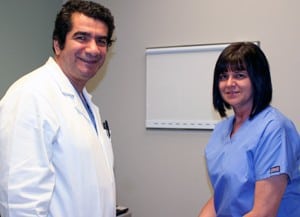Monticello Woman’s Irregular Heartbeat Cured at UAMS

Hakan Paydak, M.D., with Glenda Kay Newton Wood during a follow-up visit after he cured her irregular heartbeat
| For most of us, the electrical impulses that keep our heartbeat steady are rarely given much thought. But when the circuitry goes haywire, as it did for Glenda Kay Newton Wood of Monticello, finding the right physician is critical.
After nearly four years and two heart bypass surgeries, the situation was dire when Wood found Hakan Paydak, M.D., director of UAMS Cardiac Electrophysiology Program and Laboratory.
“I thought it was going to kill her,” said Glenda’s husband, Tim Wood.
Glenda, 48, began experiencing frequent irregular heartbeats (arrhythmias) in 2006 but was told by a cardiologist in January 2007 that it was stress related. A few months later she was taken to the emergency room at Jefferson Regional Medical Center (JRMC) after experiencing shortness of breath, nausea and heart attack-like symptoms. An angiogram found two blockages in her arteries, so she had bypass surgery. The symptoms returned about 18 months later, and additional testing showed that one of the two bypasses had failed. So another bypass surgery was performed in October 2008.
The irregular heartbeat returned with a vengeance last year. Her heart would beat out of control about 4,000 extra beats per day and sometimes slow to 40 beats per minute.
“It was just as bad emotionally as it was physically,” Glenda said. “I wondered, is my heart going to race away, or is it going to stop? It was constant, day in and day out, worrying about what was going to happen.”
When her primary care physician in Star City saw her in November 2009, he was so concerned that he sent her by ambulance to JRMC. The cardiologist there referred her to Paydak for an electrophysiology study in January.
Paydak initially treated the arrhythmia with the maximum dose of Diltiazem, a calcium channel blocker, but it was ineffective. The side effects of the drug also were worse for Glenda than the arrhythmia.
A radiofrequency catheter ablation was scheduled by March.
Unlike her bypass surgeries, which required opening her chest, a catheter ablation is minimally invasive. It involves guiding a tiny tube to the heart through blood vessels starting at the groin.
Once the catheter tip reached the heart, Paydak was able to identify the location of the problem using fluoroscopy imaging and a state-of-the-art 3-D mapping system. During the four-hour procedure he fixed the rhythm disturbance by cauterizing or burning a small amount of heart tissue.
Glenda said she is happy with the result, which allowed her to stop taking the heart medicine.
“I am so grateful that I finally saw Dr. Paydak. I feel great; I can finally do things that I didn’t have the energy to do before.”
“This is the reason I went into this field,” Paydak said of Glenda’s outcome. “This is one of the things we can cure for good, and we can eliminate the rhythm problems and all the medications.”
To learn more about the personalized care provided by our doctors using state-of-the-art equipment and technology, please visit our medical services section.
